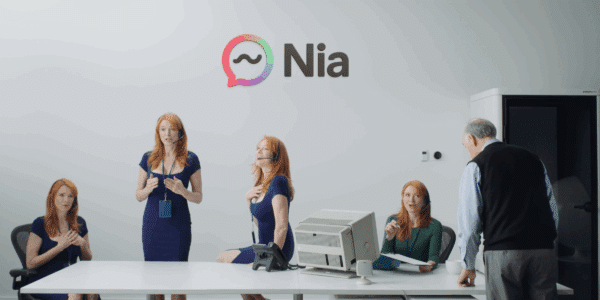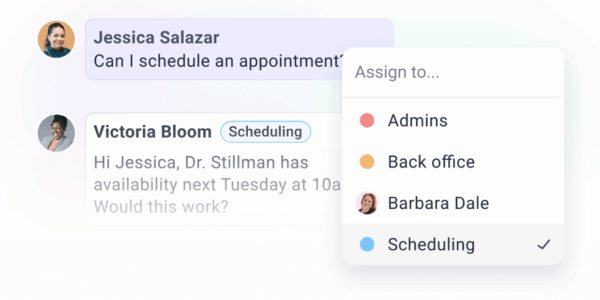Even as people are becoming more willing to go back into the doctors office for visits, the value of the televisit has left an indelible mark on patients. Though the U.S. has seen a decline in telehealth usage over the last few months with more and more people becoming vaccinated for COVID-19, a recent study showed that roughly 88% of people want to continue using telehealth services even after the pandemic.
So, if patients want telehealth, why is it declining, and what can you do at your practice to offer up the televisit in an efficient way to patients who want it?
OhMD CEO, Ethan Bechtel, recently sat down with telehealth consultant Sam Lippolis for “The Patient Conversation” to discuss the best practices for televisit implementation and growth for healthcare practices. Lippolis has years of experience in telehealth and offers a ton of insight into how practices can set themselves up for a successful hybrid approach to care where the patient can choose between a televisit and in-person care depending on the situation and their personal choice.
The importance of workflows in televisit implementation
When it comes to smoothly implementing telehealth, workflows are everything.
Many clinicians, as well as patients, have been rushed into using telehealth during COVID-19 without adequate training on workflows, technology, and best practices for how the televisit can and should be offered.
Lippolis says, now that many practices have had a chance to use televisits, it’s time to go back and fine-tune the proper workflows for each clinical situation. She suggests taking telehealth into consideration in clinical trainings in order to build workflows that are as streamlined as in-person care, if not more.
What percentage of care will utilize the televisit after COVID?
It can be hard to get stakeholders and clinicians in large health systems to buy into telehealth, or really any new technology for that matter. Many health systems had to quickly ramp up televisit implementation during the COVID-19 pandemic to continue delivering care safely.
Lippolis says many of those organizations hit an all-time high of 80% televisits during the pandemic, but most have already dropped back to 20%. In other words, practices are going back to “business as usual” with primarily in-person care.
Lippolis says that’s not how it has to be, but attributes the reversion to a general unsureness about how to develop an effective hybrid model for telehealth and in-person care. A 40% televisit to in-person model, including tools like HIPAA compliant email, text, webchat, phone calls, and video, is the right number to shoot for, she says.
So how do practices achieve that percentage of televisits? Develop the care delivery model that’s best for your patient experience. Patients love telehealth. We’ll get into how you choose what you offer and how you offer it in the next section.
Choosing the right telehealth tool for the right patient in the right situation
Streamlined care utilizing televisits is achievable when practices make it clear to patients and their staff which channels of communication should be used for different situations and needs. Is the best communication method for a prescription refill really a phone call? Can your patient effectively be triaged via a text message? Do you need an in-person visit or a televisit for a specific patient inquiry? Is the engagement with the patient different based on different situations? These are all question practices contend with every day.
Many times, thinking through how you and your staff can best help the patient can open up doors to better efficiency.
For example, if your practice wants to shift from primarily call-based patient outreach and scheduling to a text-based flow, it’s vital to advertise your textable number to patients and let them know which situations merit a text and which merit a call. You also need to make sure your staff is on board and understands which channels to push.
Here’s a tip: try adding a callout to your textable number on your practice website with a note like this:
“To schedule an appointment or pay your bill, please text us at the number below. With questions regarding your care plan and treatment, please call us instead.”
Let your patients know exactly how to reach you and when to use those channels. This clarity goes a long way in improving patient communication, and therefore, trust and satisfaction with telehealth.
One easy way to create a hybrid televisit and in-person model for patients
There isn’t a go-to playbook on how to build a hybrid model that includes both televisit and in-person visit. So where do practices start?
Here’s a tip: Schedule your first visits of the day as televisits, as well as the first few appointments after your lunch break.
Why? Your appointments are most likely to be running on time at the very start of the day and right after break. “A patient sitting on a video for 30 seconds or 2 minutes waiting feels like 4 hours, so you’ve got to be on time,” says Lippolis.
If your televisits don’t fill up for the day, you can always fill in those slots with in-person visits. Structuring your day so that you’re likely to be on time for video visits is going to keep patient satisfaction with telehealth high. Patients will be more open to and comfortable with televisits, freeing up more time in your schedule.
Tips for creating comfort and trust with televisits
The telvisit is a fairly new concept to many healthcare professionals, but even more so for patients. How can providers develop trust with patients when communicating via telehealth?
1. If your first time meeting a patient is on a televisit, focus on simple human connection. Make sure you’re close enough to the camera, making eye contact, and have a clean, simple background.
2. The more touchpoints you have with patients through texting, calling, video, etc. and the more responsive your team is to patient questions through those channels, the more patients will trust and be open to telehealth.
At the same time, how can a provider trust that they’ll be able to provide accurate diagnosis and care delivery using telehealth?
- Start with a scope that you’re comfortable with. It’s okay to start out offering only certain types of televisits for specific situations. Once you’ve gained experience and are comfortable delivering care through video or text, you can assess what other types of visits are or are not possible with those tools. From there, you can continue to expand your telehealth repertoire.
- From a clinical standpoint, consider every tool you would need to complete a certain type of patient visit in person. Can you offer those same assessments remotely via televisit? If so, how would you do it? This is a great exercise to identify opportunities for efficiency.
- Lastly, it stands to reason that if you, as the provider, are comfortable and confident in your care delivery, the patient will feel more relaxed. This goes a long, long way in building the patient relationship.
What data to look at to understand the ROI of televisits
What’s the return on investment for telehealth?
Lippolis says televisit ROI alone should be no different than for in-person visits, as long as there is payment parity.
What’s important to consider is the bigger picture of telehealth. How much time are you spending on the phone, texting patients, and conducting televisits on video? Make sure you’re leveraging the right clinicians for these tasks.
In many cases, nurses can handle patient outreach so that physicians can focus on visits both in-person and via video. This will help your practice to better allocate clinician time to improve televisit ROI.
It’s also key to keep track of your usage for different communication tools. Many EHRs can track different encounter types like phone and email, for example. Tracking this data can help to better understand ROI.
The implications of televisit reimbursements post-pandemic
CMS has yet to grant full payment parity between in-person and televisits because they haven’t yet seen the data to base this decision. Now that many practices are able to return to offering in-person care, televisits are likely to drop to 20% of care offered. Potentially lower.
If all medical practices revert back to “business as usual” with only 20% using the televisit, the data will no longer reflect a need for telehealth, nor will it unveil that telehealth can actually improve patient outcomes.
It’s important to take a step back to see how the care that you’re offering is changing value for your patients. Again, patients love telehealth. This is why a hybrid model is so appealing for many practices.
Primary care concerns with commodifying healthcare and competition on the horizon
What does the competitive landscape start to look like now that most practices and hospitals have operated with telehealth? Will practices start to push harder and faster to achieve the improved patient experiences they’ve seen using the televisit?
Lippolis says groups like Amazon Care who offer direct-to-consumer care are in essence democratizing primary care. The issue with democratization of primary care is that it makes healthcare incredibly transactional, consisting of very sporadic one-off appointments and treatments.
Lippolis stresses that this commodification of primary care makes it hard to cover the cost of the more complex conditions also treated by primary care, like comorbidity, heart failure, diabetes, depression and anxiety. Primary care holds a very important place in our healthcare system. Adapting to address competition and the changing wants and needs of patients is and will continue to be critical for patient practices.
How primary care can be the leaders of telehealth post pandemic
Before the COVID-19 pandemic, 25% of people said they would leave their primary care doctor for another who offered televisits. Since the pandemic began, that number has grown as more patients turned to telehealth out of necessity and gained comfortability with it.
Lippolis believes that if primary care providers decide to embrace telehealth rather than return to a “business as usual” pre-pandemic approach, they’ll be the ones to succeed and actually lead the charge on telehealth.
For private practices who fear they’ll be stomped out by large health systems offering televisits, Lippolis says they’re actually at an advantage. It’s much easier to implement a hybrid care model at a smaller private practice with fewer stakeholders and a smaller patient base than at a large hospital. These practices have the ability to move quicker and be more nimble in their approach.
Three words of advice from Lippolis? Embrace the future. The sooner you embrace telehealth and televisits, the further ahead of your competitors you’ll be and the better your patient experience.
Watch the full discussion
Watch the full video and read the transcript of “The Patient Conversation” with Ethan Bechtel and guest, Telehealth Consultant, Sam Lippolis.



